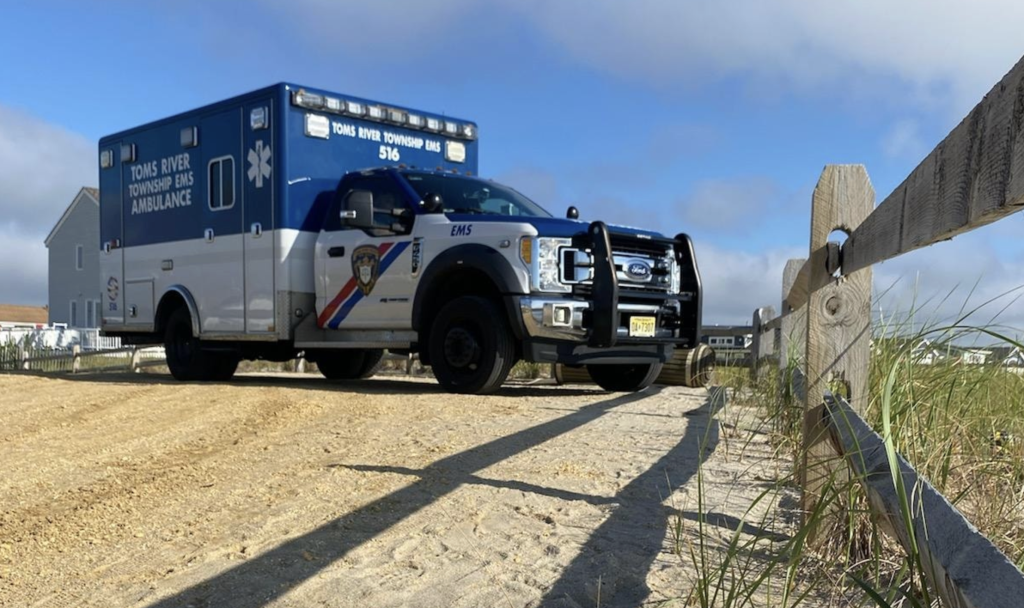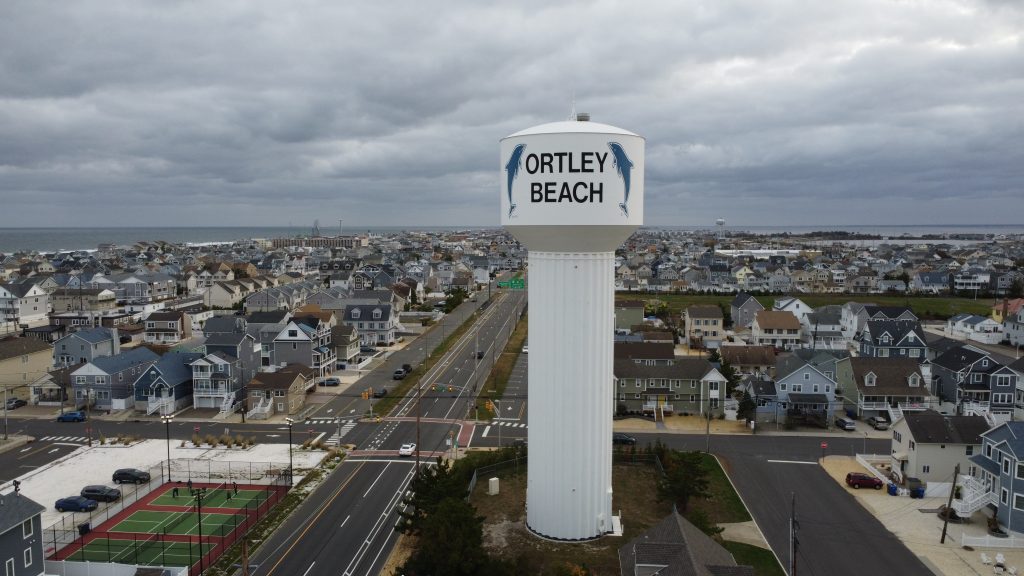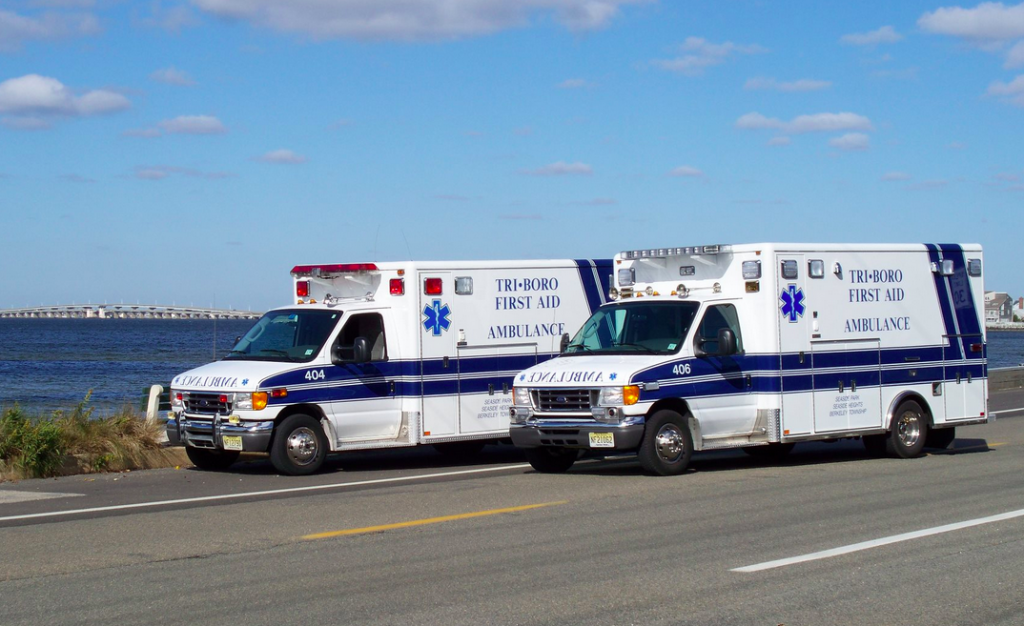
A Toms River Police EMS rig sits atop the dunes in the township’s barrier island. (Photo: Toms River Police EMS)
It has been more than a decade since the Ortley Beach First Aid Squad, made up of volunteers, dissolved due to dwindling membership – only to have its headquarters largely destroyed in Superstorm Sandy months later.
The first aid building has since been replaced by a much-appreciated pickleball court for residents, but some have argued that the level of emergency medical services provided to the barrier island – specifically Ortley Beach – does not comport with an increasing population and the comparatively high percentage of taxation the neighborhood pays to the municipal government.
The issue is more complex, however, than simply hiring an extra EMT into the Toms River Police EMS service, a paid squad under the auspices of the police department that provides a great deal of EMS response in Toms River. A few volunteer squads remain, but are located on the mainland, though they do provide mutual aid to the barrier island in emergencies. The bottom line, officials said at a recent meeting of the township council, is that the manpower simply doesn’t exist.
“There has been a lot of discussion over the fact that we do not have a full-time ambulance on the island,” said resident Barbara Hollis, pointing out that the age of many island residents is older than the township’s average.
During the bulk of the summer season, Toms River Police EMS does station an ambulance on the island from 7 a.m. to 7 p.m., the time when the majority of calls are received, however that revelation did not convince the residents.
“We can’t plan our heart attacks around that schedule,” Hollis said. “Somewhere in that budget is enough money, because we pay 34 percent of the taxes.”
Officials disputed the island represent 34 percent of the township’s entire tax base, but acknowledged the valuable location near the waterfront does contribute a significant sum. Ultimately, the challenges in providing coverage go beyond money, said Councilman Kevin Geoghegan, himself a current volunteer EMT and retired police officer.
“EMS in this country is a disaster,” said Geoghegan, pulling no punches. “No one wants to go into that field anymore. I understand the concerns, but it happens not only across the township, nor the county, but the entire state, every day.”
Geoghegan pointed out the now-common signs advertising State Police recruiting on billboards along the state’s highways. At one time, he said, the New Jersey State Police had a recruiting waiting list that measured in the tens of thousands. Now, they hope advertising can help fill the ranks.
“There were more paramedics in Ocean County in 2002 than there are today,” said Geoghegan. “When you call 911, it’s the biggest crisis in your life. Sometimes it takes 45 minutes to get out of the [ambulance] at the hospital, because they don’t have room for [the patient].”
Ortley Beach residents also inquired as to whether the Seaside Park-based Tri-Boro First Aid Squad, a mixed squad consisting of both volunteers and professional, paid EMTs, would be a better option since the squad is located geographically close by. Indeed, officials said, they have previously reached out to Tri-Boro, asking about such an arrangement.
“The Tri-Boro option was brought to our attention, but when we reached out to them, they told us they had no ability to provide primary service,” said Louis Amoruso, the township’s business administrator. “We actually went into Tri-Boro’s area [to provide mutual aid] more often than Tri-Boro came into Ortley Beach.”
Lavallette First Aid Squad is now the barrier island’s only remaining all-volunteer squad, though membership is hurting there as well. The Dover-Brick Beach EMS squad, located in Normandy Beach, disbanded recently, and sold their former headquarters to a developer, donating the proceeds to the nursing program at Ocean County College.
Tri-Boro provides primary EMS service to Seaside Park, Seaside Heights and South Seaside Park. Toms River Police EMS as well as local volunteer squads provide mutual aid to those communities, and occasionally a volunteer squad provides service to Ortley Beach and other island communities as well – a concern despite being appreciated by residents. One resident who spoke at the council meeting said it took 20 minutes for an ambulance to come all the way from Silverton to Ortley Beach in response to a possible heart attack.

Ortley Beach’s pickleball court (bottom left) on the former First Aid Squad property. (Photo: Daniel Nee)
“You also have to deal with construction on the bridges, the summer traffic, everything else,” the resident said. “That doesn’t mean anything if your spouse is lying on the floor dying, waiting for an ambulance, because of a budget issue.”
As a whole, Toms River’s response times for emergency medical calls averages around 9 minutes, less than the 14 minute average county-wide.
Amoruso said Toms River, like other towns and squads, prioritizes calls based on the potential severity of the condition of the patient.
“If the call comes in and it’s a sprained ankle, it doesn’t get the same priority as, say, a heart attack,” he said. “It’s just a very, very difficult problem to deal with.”
Toms River, in its capital budget for 2023, purchased one new ambulance as well as a power stretcher. The stretcher, Amoruso said, will help limit injuries to EMTs from lifting patients, leaving the township will a more filled-out roster available to respond to calls.
Officials pledged to continue looking into the best options for response times to the island.
“It is a scary thing,” said Council President Matthew Lotano.


Police, Fire & Courts
Prosecutors: Toms River Man, 28 Doxxed and Arrested After Traveling to Meet Minor Abroad

Police, Fire & Courts
Cops: Toms River Man, 59, Set House on Fire

Police, Fire & Courts
Ocean County Drug Dealer Gets 11 Year Sentence Following Guilty Plea

Police, Fire & Courts
Ocean County Drug Dealer Gets 11 Year Sentence Following Guilty Plea

Police, Fire & Courts
Prosecutors: Toms River Man, 28 Doxxed and Arrested After Traveling to Meet Minor Abroad






